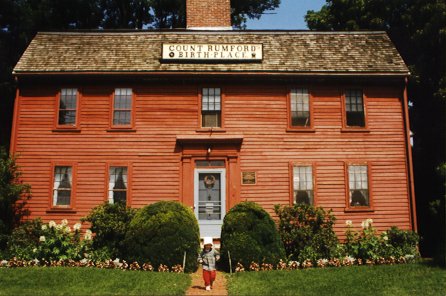Count Rumford
Today, we meet a Bavarian count who was born in colonial Massachusetts. The University of Houston's College of Engineering presents this series about the machines that make our civilization run, and the people whose ingenuity created them.
Years ago, my wife and I strolled through the People's Park in Munich, Germany. That lovely two-mile natural preserve with trees and a river running through it forms a huge part of the city.
The park was designed by Benjamin Thompson, an American who was raised in Woburn, Massachusetts, just before the American Revolution. He wrestled out a homemade education in Boston and, when he was only 18, went off to Rumford, Massachusetts, as its new schoolmaster. He soon married a wealthy 31-year-old widow in Rumford. He also took up spying on the colonies for the British.
When the colonists learned what he was up to, he deserted his wife and a new daughter and fled to England. There he devoted himself to shameless social climbing that eventually put him in a high-ranking position with the Bavarian court in Munich.
His life took on a new coloration in Bavaria. He used his technical insight to institute social reforms that were years ahead of their time. He devised public works, military reforms, and poorhouses. He equipped them with radical kitchen, heating, and lighting systems. He created that lovely People's Park.
When he was made a Count of the Holy Roman Empire he did a surprising thing -- he took the name of the town he'd once fled -- the name of Rumford. And it's Count Rumford whom history remembers. He's most famous for experiments he made five years later while he was working with field artillery. He found that, by boring a cannon barrel under water with a blunt bit, he could heat the water to boiling and then keep it boiling.
People at the time thought that heat was a fluid -- a kind of aether, called caloric, that flowed in and out of materials. Caloric was the last of the old Aristotelian essences -- earth, air, water, and fire. It was supposed to be indestructible and uncreatable. Rumford's results flew in the face of the caloric theory. Now it was clear that mechanical work could go on creating caloric as long as anyone might wish.
Rumford's story takes a last ironic turn. The French chemist, Lavoisier, who was beheaded during the French Revolution, had given caloric its name. When Rumford left Bavaria for England and France, he took up with Lavoisier's widow. Their four-year relationship ended in a short and disastrous marriage. Before the marriage Rumford crowed:
I think I shall live to drive caloric off the stage as the late Lavoisier drove away [the theory before it]. What a singular destiny for the wife of two Philosophers!
Count Rumford had, indeed, been instrumental in driving caloric off the stage, and setting a foundation for the first law of thermodynamics. But is it any great surprise that the marriage failed!
I'm John Lienhard, at the University of Houston, where we're interested in the way inventive minds work.
(Theme music)
Brown, S.C., Benjamin Thompson, Count Rumford. Cambridge, MA: MIT Press, 1981.
This is a revised version of an earlier program, Engines Episode 4.

Benjamin Thompson/Count Rumford's Birthplace
Photo by John Lienhard

Scene in Rumford's English Garden in Munich
Photo by John Lienhard